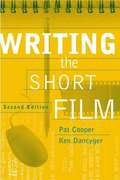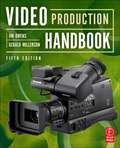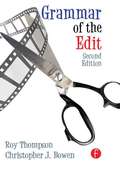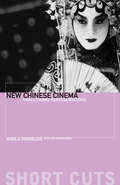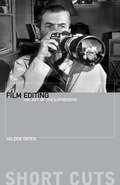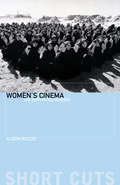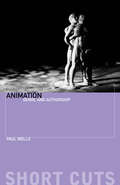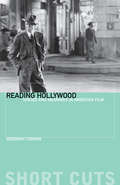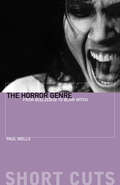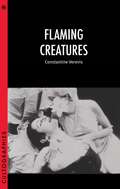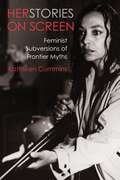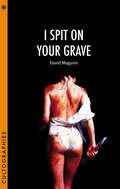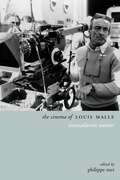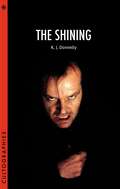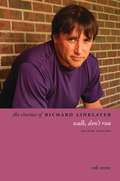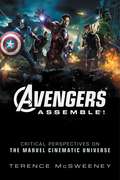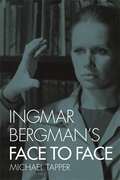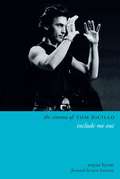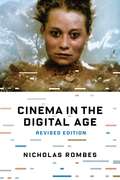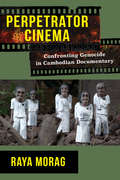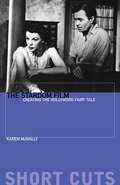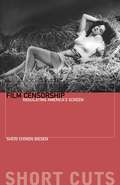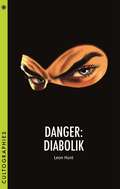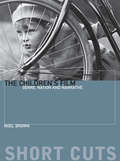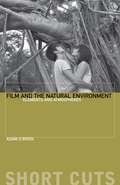- Table View
- List View
Writing the Short Film (second edition)
by Ken Dancyger Pat CooperWriters who want to write a fil will find this to be a useful book. The usefulness of this book goes beyond the writing or filmmaking class.
Video Production Handbook (5th Edition)
by Jim Owens Gerald MillersonTechniques matter! Great ideas don't automatically translate into great programs. It's not enough simply to show what is going on. The way you present your subject will influence how your audience responds. You need to choose your picture and sound carefully, to convey your ideas in an interesting, persuasive way. This book will show you how. Video Production Handbook shows the full production process, from inception of idea to final distribution. The book focuses especially on why each step occurs as it does and provides guidance in choosing the simplest methods of creating the shots you want in your video project. Concentrating on the techniques and concepts behind the latest equipment, this book demonstrates the fundamental principles needed to create good video content on any kind of budget. Suitable for students and beginning videographers, the new edition of this classic text retains its clarity and directness but has been completely revised and updated. This practical sourcebook has been specially prepared to give you an at-a-glance guide to quality video program-making on a modest budget. Emphasis throughout is on excellence with economy; whether you are working alone or with a small multi-camera group. The well-tried techniques detailed here will steer you through the hazards of production, helping you to avoid those frustrating, time-wasting problems, and to create an effective video program. * Highly visual: more than 450 full color photos and illustrations demonstrate techniques * Modern: Revised by Jim Owens, who brings a wealth of hands-on experience to the text; up-to-date information on current equipment, techniques, and new distribution outlets such as the Web and mobile phones * A complete resource: Detailed teaching ancillaries are available for instructors, including instructor's manual, test bank, sample syllabi, image collection, video content, and more * Brand new coverage of contemporary distribution methods * Interviews featuring industry professionals provide students with inside knowledge of the industry * Sidebars featuring new coverage of topics such as shooting for 3D, shooting with HDSLRs for video, and much more!
Grammar of the Edit (2nd edition)
by Roy Thompson Christopher J. BowenLearn the basic "grammar" of editing films and videos in Grammar of the Edit! This book shows you in no uncertain terms (independently of software) what you absolutely need to know to edit your video production. Whether you are just learning how to edit or you need a refresher, this book gives you a basic toolkit to understand the basic terms and the common practices of editing to help create a coherent and meaningful story or visual presentation. This book concentrates on where and how an edit is made and teaches you how to answer the simple question: 'What do I need to do in order to make a good edit between two shots?' Grammar of the Edit begins with an explanation of the basic rules of visual construction that will allow you to arrange your footage logically. The book takes you from the basic vocabulary of editing, to knowing when to cut (and why), to transitions, and finally to good working practices. Designed as an easy-to-use reference, each topic is covered succinctly and is accompanied by clear photographs and diagrams that illustrate the key concepts presented in the book. Simple, elegant, and easy to use, Grammar of the Edit is a staple of any filmmaker's library.
New Chinese Cinema: Challenging Representations (Short Cuts)
by Sheila CorneliusNew Chinese Cinema: Challenging Representations examines the ‘search for roots’ films that emerged from China in the aftermath of the Cultural Revolution. The authors contextualize the films of the so-called Fifth Generation directors who came to prominence in the 1980s and 1990s, such as Chen Kaige, Zhang Yimou, and Tian Zhuangzhuang. Including close analysis of such pivotal films as Farewell My Concubine, Raise the Red Lantern, and The Blue Kite, this book also examines the rise of contemporary Sixth Generation underground directors whose themes embrace the disaffection of urban youth.
Film Editing: The Art of the Expressive (Short Cuts)
by Valerie OrpenFilm Editing provides an introduction to the craft of editing in the non-silent film. In clear and accessible language, Valerie Orpen considers editing as an expressive strategy rather than a mere technique. She reveals that editing can be approached and studied in a similar way to other aspects of film. Traditionally, studies on editing or montage tend to focus on silent cinema, yet this book claims that an examination of editing should also consider the role of the soundtrack. The aim of Film Editing is to examine the way in which editing can make meaning. The book addresses editing as part of a wider context and as a crucial element of the overarching design and vision of a film. Consequently, this book incorporates other parameters, such as mise-en-scène, framing, sound, genre, history, and performance. By examining a number of mainstream and art films, such as Godard's A bout de souffle, Hitchcock's Rear Window, and Scorsese's Raging Bull, Film Editing seeks to dispel the notion that editing is necessarily polarized as continuity versus discontinuity.
Women's Cinema: The Contested Screen (Short Cuts)
by Alison ButlerWomen's Cinema provides an introduction to critical debates around women's filmmaking and relates those debates to a variety of cinematic practices. Taking her cue from the groundbreaking theories of Claire Johnston, Alison Butler argues that women's cinema is a minor cinema that exists inside other cinemas, inflecting and contesting the codes and systems of the major cinematic traditions from within. Using canonical directors and less established names, ranging from Chantal Akerman to Moufida Tlatli, as examples, Butler argues that women's cinema is unified in spite of its diversity by the ways in which it reworks cinematic conventions.
Animation: Genre and Authorship (Short Cuts)
by Paul WellsAnimation: Genre and Authorship explores the distinctive language of animation, its production processes, and the particular questions about who makes it, under what conditions, and with what purpose. In this first study to look specifically at the ways in which animation displays unique models of ‘auteurism’ and how it revises generic categories, Paul Wells challenges the prominence of live-action moviemaking as the first form of contemporary cinema and visual culture. The book also includes interviews with Ray Harryhausen and Caroline Leaf, and a full timeline of the history of animation.
Reading Hollywood: Spaces and Meanings in American Film (Short Cuts)
by Deborah ThomasThis book examines the treatment of space and narrative in a selection of classic films including My Darling Clementine, It's a Wonderful Life, and Vertigo. Deborah Thomas employs a variety of arguments in exploring the reading of space and its meaning in Hollywood cinema and film generally. Topics covered include the importance of space in defining genre (such as the necessity of an urban landscape for a gangster film to be a gangster film); the ambiguity of offscreen space and spectatorship (how an audience reads an unseen but inferred setting), and the use of spatially disruptive cinematic techniques such as flashback to construct meaning.
The Horror Genre: From Beelzebub to Blair Witch (Short Cuts)
by Paul WellsA comprehensive introduction to the history and key themes of the genre. The main issues and debates raised by horror, and the approaches and theories that have been applied to horror texts are all featured. In addressing the evolution of the horror film in social and historical context, Paul Wells explores how it has reflected and commented upon particular historical periods, and asks how it may respond to the new millennium by citing recent innovations in the genre's development, such as the "urban myth" narrative underpinning Candyman and The Blair Witch Project. Over 300 films are treated, all of which are featured in the filmography.
Flaming Creatures (Cultographies)
by Constantine VerevisBanned soon after its first midnight screenings, the prints seized and the organizers arrested, Jack Smith’s incendiary Flaming Creatures (1963) quickly became a cause célèbre of the New York underground. Championed and defended by Jonas Mekas and Susan Sontag, among others, the film wildly and gleefully transgresses nearly every norm of Hollywood morality and aesthetics. In a surreal and visually dense series of episodes, the titular “creatures” reenact scenes drawn from the collective cinematic unconscious, playing on mainstream film culture’s moral code in a way that is at once a love letter to classical Hollywood and a searing send-up of its absurdities.Tracing the film’s production and reception history, Constantine Verevis argues that it embodies a unique type of cinematic rewriting, one that combines Smith’s multifaceted artistic work with exotic fragments drawn from the cinematic past. This study of Smith’s magnum opus explores its status as a cult film that appropriates the visual texture, erotic nuance, and overt fabrication of old Hollywood exoticism.
Herstories on Screen: Feminist Subversions of Frontier Myths
by Professor Kathleen CumminsFrom the late 1970s into the early 1990s, a generation of female filmmakers took aim at their home countries’ popular myths of the frontier. Deeply influenced by second-wave feminism and supported by hard-won access to governmental and institutional funding and training, their trailblazing films challenged traditionally male genres like the Western. Instead of reinforcing the myths of nationhood often portrayed in such films—invariably featuring a lone white male hero pitted against the “savage” and “uncivilized” native terrain—these filmmakers constructed counternarratives centering on women and marginalized communities. In place of rugged cowboys violently removing indigenous peoples to make the frontier safe for their virtuous wives and daughters, these filmmakers told the stories of colonial and postcolonial societies from a female and/or subaltern point of view.Herstories on Screen is a transnational study of feature narrative films from Australia, Canada, the United States, and New Zealand/Aotearoa that deconstruct settler-colonial myths. Kathleen Cummins offers in-depth readings of ten works by a diverse range of women filmmakers including Jane Campion, Julie Dash, Merata Mita, Tracey Moffatt, and Anne Wheeler. She reveals how they skillfully deploy genre tropes and popular storytelling conventions in order to critique master narratives of feminine domesticity and purity and depict women and subaltern people performing acts of agency and resistance. Cummins details the ways in which second-wave feminist theory and aesthetics informed these filmmakers’ efforts to debunk idealized Anglo-Saxon femininity and motherhood and lay bare gendered and sexual violence and colonial oppression.
I Spit on Your Grave (Cultographies)
by David MaguireThere is no denying that Meir Zarchi’s I Spit on Your Grave (1978) deserves its title as one of the most controversial films ever made. While many condemn it as misogynistic, others praise it for raising uncomfortable issues about sexual violence. While its reputation as a cult film has undoubtedly been cemented by its unique position in the 1970s/80s exploitation era and the "video nasties" scandal, it has also become mythologized by its own official and unofficial franchises.David Maguire examines why the film still continues to provoke fierce debate forty years on, not only investigating the historical, social, and political landscape into which the film was first released—and condemned—but also examining how it is has inadvertently become ground zero for the rape-revenge genre because of its countless imitators. The book explores how academic study has reevaluated the film’s importance as a cultural statement on gender, the conflicting readings that it throws up, the timeless appeal of its story as examined through folklore and mythology, and its updating to reflect contemporary issues in a post-9/11 world of vengeance and retaliation.
The Cinema of Louis Malle: Transatlantic Auteur (Directors' Cuts)
by Philippe MetArguably a pioneer of the French New Wave (with Ascenseur pour l’échafaud, 1957) Louis Malle went on to enjoy an acclaimed yet provocative and versatile transatlantic career. This collection of original essays proposes to reassess his richly eclectic and boldly subversive oeuvre and redress the surprising critical neglect it has suffered over the years. It does so through a combination of transversal and monographic analyses that use a variety of critical lenses and theoretical tools in order to examine Malle’s documentaries as well as his fiction features (and, more importantly, the constant shuttling and uniquely persistent cross-pollination between those two cinematic approaches), illuminate the profound, lasting dialogue his films entertained with literature and theater, bring to the fore their sustained, albeit often oblique autobiographical thrust along with their scathing sociopolitical critique, and scrutinize the alternating use of stars and non-professional actors.In addition, the volume features an exclusive interview with the acclaimed playwright John Guare (a close friend and collaborator of Louis Malle’s who scripted Atlantic City) and is bookended by a foreword by Volker Schlöndorff and an afterword by Wes Anderson, two renowned filmmakers who articulate their admiration for, and the seminal influence of, their predecessor.
The Shining (Cultographies)
by Kevin J. DonnellyStanley Kubrick’s The Shining (1980) is an esteemed member of the twentieth century’s pantheon of outstanding films while also perhaps being the director’s most accessible film. It is a rarity in that on the one hand it was a successful mainstream horror film about a violent father in a deserted and haunted hotel, but on the other is a more rarefied and esoteric object for cult audiences who are convinced that the film means something totally different. Indeed, the film appears replete with enigmatic and provocative allusions, which provide The Shining with an almost unmatched sense of resonance. Seeing the film as a vehicle for secret messages has led to a myriad of different interpretations, which has helped elevate the film’s cult status over the years to make it a special case in cinema. Indeed, it is so singular that it arguably even redefines the notion of cult film. This volume investigates The Shining’s most fascinating aspects as a film while also addressing the range of meanings and interpretations assigned to the film, looking into what has made it one of the key cult films of the last half century.
The Cinema of Richard Linklater: Walk, Don't Run (Directors' Cuts)
by Rob StoneFrom Slacker (1991), a foundational work of independent American cinema, to the Before trilogy, Richard Linklater’s critically acclaimed films and aesthetic ambition have earned him a place as one of the most important contemporary directors. In this second edition of The Cinema of Richard Linklater, Rob Stone shows how Linklater’s latest films have redefined our understanding of his work. He offers critical discussions and analysis of all of Linklater’s films, including Before Midnight (2013) and Everybody Wants Some!! (2016), as well as new interviews with Linklater and a chapter on Boyhood (2014), hailed as one of the best films of the twenty-first century.Stone explores the theoretical, practical, contextual, and metaphysical elements in Linklater’s filmography, especially his experimentation with cinematic representations of time and growth. He demonstrates that fanciful lives and lucid dreams are as central as alternative notions of America and time to Linklater’s films. Stone also considers Linklater’s collaborative working practices, his deployment of such techniques as rotoscoping, and his innovative distribution strategies. Thoroughly revised, updated, and extended, the book includes analysis of all of Linklater’s films, including Dazed and Confused (1993), Waking Life (2011), and A Scanner Darkly (2006) as well as his documentaries, short films, and side projects.
Avengers Assemble!: Critical Perspectives on the Marvel Cinematic Universe
by Terence McSweeneyWe are living in the age of the superhero and we cannot deny it. <P><P>Avengers Assemble! is a vibrant and theoretically informed interrogation of one of the defining and most financially successful film franchises of the new millennium. In the first single-authored monograph on the topic of the Marvel cinematic universe, Terence McSweeney asks, "Why has the superhero genre reemerged so emphatically in recent years?" In an age where people have stopped going to the cinema as frequently as they used to, they returned to it in droves for the superhero film. What is it about these films that has resonated with audiences all around the globe? Are they just disposable pop culture artifacts or might they have something interesting to say about the fears and anxieties of the world we live in today? <P><P>Beginning with Iron Man in 2008, this study provocatively explores both the cinematic and the televisual branches of the series across ten dynamic and original chapters from a diverse range of critical perspectives which analyse their status as an embodiment of the changing industrial practices of the blockbuster film and their symbolic potency as affective cultural artifacts that are profoundly immersed in the turbulent political climate of their era.
Ingmar Bergman's Face to Face (Treasury Of The Indic Sciences Ser.)
by Michael TapperThe 1976 premiere of Face to Face came at the height of director-screenwriter Ingmar Bergman's career. Prestigious awards and critical acclaim had made him into a leading name in European art cinema, yet today Face to Face is a largely overlooked and dismissed work.This book tells the story of its rise and fall. It presents a new portrait of Bergman as a political artist exploring a new medium with huge public impact: television. Inspired by Henrik Ibsen, feminism, and alternative psychotherapy, he made a series of portraits of the modern bourgeois family focusing on the plight of women; Face to Face followed in the tracks of The Lie (1970) and Scenes from a Marriage (1973). By his workbooks, engagement planners, and other archival material, we can trace his investigation into the heart of repressive family structures to eventually glimpse a way out. This volume culminates in an extensive study of the two-year process from the first outlines of the screenplay to the reception and aftermath of Face to Face. It thus offers a unique insight into Bergman's world, his ideas and artistry during a turbulent time in cinema history.
The Cinema of Tom DiCillo: Include Me Out (Directors' Cuts)
by Wayne ByrneThis volume considers for the first time in a single collection this acclaimed, award-winning director's entire oeuvre, addressing and analyzing themes such as identity, family, and masculinity, supported by in-depth coverage of the generic and aesthetic aspects of DiCillo's distinctive and influential film style. Through detailed chapters on each of DiCillo's feature films, presented here is a candid look behind-the-scenes of both the American independent film industry - from the No Wave movement of the 1980s, through the Indie boom of the 1990s, to the contemporary milieu - and the Hollywood studio system. This study documents the writing, production, and release of every DiCillo picture, each followed by an extensive Q&A with the director. Also featured are exclusive interviews and commentary with many cast members and collaborators, and members of legendary rock group, The Doors. Films covered include Johnny Suede, Living In Oblivion, Box of Moonlight, The Real Blonde, Double Whammy, Delirious, When You're Strange, and Down in Shadowland.
Cinema in the Digital Age
by Nicholas RombesHave digital technologies transformed cinema into a new art, or do they simply replicate and mimic analogue, film-based cinema? Newly revised and expanded to take the latest developments into account, Cinema in the Digital Age examines the fate of cinema in the wake of the digital revolution. Nicholas Rombes considers Festen (1998), The Blair Witch Project (1999), Timecode (2000), Russian Ark (2002), and The Ring (2002), among others. Haunted by their analogue pasts, these films are interested not in digital purity but rather in imperfection and mistakes—blurry or pixilated images, shaky camera work, and other elements that remind viewers of the human behind the camera.With a new introduction and new material, this updated edition takes a fresh look at the historical and contemporary state of digital cinema. It pays special attention to the ways in which nostalgia for the look and feel of analogue disrupts the aesthetics of the digital image, as well as how recent films such as The Social Network (2010) and The Girl with the Dragon Tattoo (2011)—both shot digitally—have disguised and erased their digital foundations. The book also explores new possibilities for writing about and theorizing film, such as randomization.
Perpetrator Cinema: Confronting Genocide in Cambodian Documentary (Nonfictions)
by Raya MoragPerpetrator Cinema explores a new trend in the cinematic depiction of genocide that has emerged in Cambodian documentary in the late twentieth- and early twenty-first centuries. While past films documenting the Holocaust and genocides in Yugoslavia, Rwanda, and elsewhere have focused on collecting and foregrounding the testimony of survivors and victims, the intimate horror of the autogenocide enables post–Khmer Rouge Cambodian documentarians to propose a direct confrontation between the first-generation survivor and the perpetrator of genocide. These films break with Western tradition and disrupt the political view that reconciliation is the only legitimate response to atrocities of the past. Rather, transcending the perpetrator’s typical denial or partial confession, this extraordinary form of “duel” documentary creates confrontational tension and opens up the possibility of a transformation in power relations, allowing viewers to access feelings of moral resentment.Raya Morag examines works by Rithy Panh, Rob Lemkin and Thet Sambath, and Lida Chan and Guillaume Suon, among others, to uncover the ways in which filmmakers endeavor to allow the survivors’ moral status and courage to guide viewers to a new, more complete understanding of the processes of coming to terms with the past. These documentaries show how moral resentment becomes a way to experience, symbolize, judge, and finally incorporate evil into a system of ethics. Morag’s analysis reveals how perpetrator cinema provides new epistemic tools and propels the recent social-cultural-psychological shift from the era of the witness to the era of the perpetrator.
The Stardom Film: Creating the Hollywood Fairy Tale (Short Cuts)
by Karen McNallySince the earliest days of the movie industry, Hollywood has mythologized itself through stories of stardom. A female protagonist escapes the confines of rural America in search of freedom in a western dream factory; an ambitious, conceited movie idol falls from grace and discovers what it means to embody true stardom; or a fading star confronts Hollywood’s obsession with youth by embarking on a determined mission to reclaim her lost fame. In its various forms, the stardom film is crucial to understanding how Hollywood has shaped its own identity, as well as its claim on America’s collective imagination.In the first book to focus exclusively on these modern fairy tales, Karen McNally traces the history of this genre from silent cinema to contemporary film and television to show its significance to both Hollywood and broader American culture. Drawing on extensive archival research, she provides close readings of a wide range of films, from Souls for Sale (1923) to A Star is Born (1937 and 1954) and Judy (2019), moving between fictional narratives, biopics, and those that occupy a space in between. McNally considers the genre’s core set of tropes, its construction of stardom around idealized white femininity, and its reflections on the blurred boundaries between myth, image, and reality. The Stardom Film offers an original understanding of one of Hollywood’s most enduring genres and why the allure of fame continues to fascinate us.
Film Censorship: Regulating America's Screen (Short Cuts)
by Sheri Chinen BiesenFilm Censorship is a concise overview of Hollywood censorship and efforts to regulate American films. It provides a lean introductory survey of U.S. cinema censorship from the pre-Code years and classic studio system Golden Age—in which film censorship thrived—to contemporary Hollywood. From the earliest days of cinema, movies faced controversy over screen images and threats of censorship. This volume draws extensively on primary research from motion picture archives to unveil the fascinating behind-the-scenes history of cinema censorship and explore how Hollywood responded to censorial constraints on screen content in a changing American cultural and industrial landscape.This primer on American film censorship considers the historical evolution of motion-picture censorship in the United States spanning the Jazz Age Prohibition era, lobbying by religious groups against Hollywood, industry self-censorship for the Hays Office, federal propaganda efforts during wartime, easing of regulation in the 1950s and 1960s, the MPAA ratings system, and the legacy of censorship in later years. Case studies include The Outlaw, The Postman Always Rings Twice, Scarface, Double Indemnity, Psycho, Bonnie and Clyde, Midnight Cowboy, and The Exorcist, among many others.
Danger: Diabolik (Cultographies)
by Leon HuntDanger: Diabolik (1968) was adapted from a comic that has been a social phenomenon in Italy for over fifty years, featuring a masked master criminal—part Fantômas, part James Bond—and his elegant companion Eva Kant. The film partially reinvents the character as a countercultural prankster, subverting public officials and the national economy, and places him in a luxurious and futuristic underground hideout and Eva in a series of unforgettable outfits. A commercial disappointment on its original release, Danger: Diabolik's reputation has grown along with that of its director, Mario Bava, the quintessential cult auteur, while the pop-art glamour of its costumes and sets have caught the imagination of such people as Roman Coppola and the Beastie Boys.This study examines its status as a comic-book movie, including its relation both to the original fumetto and to its sister-film, Barbarella. It traces its production and initial reception in Italy, France, the U.S., and the UK, and its cult afterlife as both a pop-art classic and campy "bad film" featured in the final episode of Mystery Science Theatre 3000.
The Children's Film: Genre, Nation, and Narrative (Short Cuts)
by Noel BrownFilms for children and young people are a constant in the history of cinema, from its beginnings to the present day. This book serves as a comprehensive introduction to the children's film, examining its recurrent themes and ideologies, and common narrative and stylistic principles. Opening with a thorough consideration of how the genre may be defined, this volume goes on to explore how children's cinema has developed across its broad historical and geographic span, with particular reference to films from the United States, Britain, France, Denmark, Russia, India, and China. Analyzing changes and continuities in how children's film has been conceived, it argues for a fundamental distinction between commercial productions intended primarily to entertain, and non-commercial films made under pedagogical principles, and produced for purposes of moral and behavioral instruction. In elaborating these different forms, this book outlines a history of children's cinema from the early days of commercial cinema to the present, explores key critical issues, and provides case studies of major children's films from around the world.
Film and the Natural Environment: Elements and Atmospheres (Short Cuts)
by Adam O'BrienEnvironmental themes are present in cinema more than ever before. But the relationship between film and the natural world is a long and complex one, not reducible to issues such as climate change and pollution. This volume demonstrates how an awareness of natural features and dynamics can enhance our understanding of three key film-studies topics – narrative, genre, and national cinema. It does so by drawing on examples from a broad historical and geographical spectrum, including Sunrise, A River Called Titas, and Profound Desires of the Gods. The first introductory text on a topic which has long been overlooked in the discipline, Film and the Natural Environment argues that the nonhuman world can be understood not just as a theme but as a creative resource available to all filmmakers. It invites readers to consider some of the particular strengths and weaknesses of cinema as communicator of environmental phenomena, and collates ideas and passages from a range of critics and theorists who have contributed to our understanding of moving images and the natural world.
